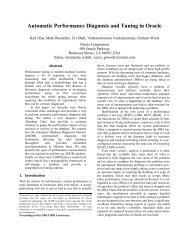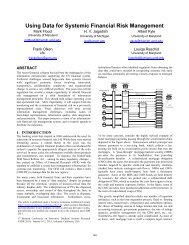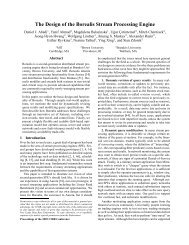SwissBox: An Architecture for Data Processing Appliances
SwissBox: An Architecture for Data Processing Appliances
SwissBox: An Architecture for Data Processing Appliances
You also want an ePaper? Increase the reach of your titles
YUMPU automatically turns print PDFs into web optimized ePapers that Google loves.
network fabric. Each S-Blade is a multicore processor where each<br />
core has an associated FPGA and disk drive. <strong>Data</strong> is streamed from<br />
the disks to the cores, with the FPGAs acting as filters which decompress<br />
the data and also execute relational operators such as selection<br />
and projection. In this way, an important part of the SQL<br />
processing is offloaded from the CPUs. TwinFin does not distinguish<br />
storage and data processing nodes, allowing <strong>for</strong> tighter integration<br />
of layers and, presumably, more optimized query execution.<br />
Common to all these plat<strong>for</strong>ms is the combination of off-theshelf<br />
components and a customized architecture that also includes<br />
specialized hardware. <strong>SwissBox</strong> is built in a similar fashion, but<br />
aims to explore in general the many cross-layer optimizations and<br />
alternative data processing techniques that become feasible in these<br />
new plat<strong>for</strong>ms.<br />
1.2 Background: Use cases<br />
<strong>SwissBox</strong> is motivated by real use cases provided by our industrial<br />
partners in the Enterprise Computing Center at ETH Zurich<br />
(www.ecc.ethz.ch). These emphasize the limitations of existing<br />
systems and suggest that a custom appliance could be a better<br />
approach to address them. Here, we focus on two such cases that<br />
underline the importance of cross layer optimizations.<br />
The first is from Amadeus, the leading airline reservation provider.<br />
Amadeus acts as a cloud provider to the travel industry. Airlines,<br />
airports, travel agencies, and national authorities access reservation<br />
in<strong>for</strong>mation through data services. Consequently, all queries have<br />
strict response time requirements (less than 2 seconds), and updates<br />
must also be propagated under tight time constraints. These<br />
guarantees must be maintained even under peak load (e.g., when a<br />
storm closes multiple airports in a region and a large wave of cancellations,<br />
re-bookings, and flight changes take place within a very<br />
short period). Furthermore, the query load does not consist solely<br />
of exact match queries: there is an increasing need <strong>for</strong> supporting<br />
complex queries under the same latency guarantees (<strong>for</strong> example,<br />
queries related to security).<br />
As we have shown [16], the combination of tight latency guarantees<br />
and wide variety of loads cannot be handled with existing engines.<br />
The approach of materializing a view and using customized<br />
indexes <strong>for</strong> each data service quickly reaches a limit on scalability,<br />
not to mention the excessive maintenance cost associated with the<br />
full set of views and indexes necessary in a system of this size.<br />
The challenge of the Amadeus use-case is combining OLTP and<br />
OLAP in a single system under very tight response time constraints.<br />
The requirements are as follows: deterministic and predictable behavior<br />
under a range of query complexity and update loads without<br />
the maintenance ef<strong>for</strong>t of complex tuning parameters, scaling to a<br />
large number of processing nodes, and enough reliability <strong>for</strong> continuous<br />
operation.<br />
Existing commercial appliances address some, but not all, of<br />
these. All aim at reducing administration costs by removing tuning<br />
options: BWA automates schema organization and index creation,<br />
while TwinFin simply does without them. However, none<br />
of the commercial appliances we discuss provide, e.g., predictable<br />
response times or support <strong>for</strong> heavy update loads.<br />
The second use case comes from the banking industry, and arises<br />
from the combination of increasing volumes of automated trading<br />
and the increasing complexity of regulations governing such trades.<br />
Algorithmic trading results in a high volume trade stream where the<br />
latency between placing the order and the order being executed is<br />
a key factor in the potential earnings. Existing systems can neither<br />
cope with the volume nor process the data fast enough to keep the<br />
latency to an acceptable minimum [13]. The need to inspect these<br />
real time streams <strong>for</strong> breaches of regulations, unauthorized trades,<br />
and violations of risk thresholds is a daunting but critical task.<br />
The biggest challenge here is processing large volumes of data<br />
under tight latency constraints, with the processing involved becoming<br />
increasingly complex and sophisticated over time. The requirements<br />
we draw from the banking use case are: wire-speed data<br />
processing, low latency responses, dealing with data high volumes<br />
in real time, and scaling in both bandwidth and query complexity.<br />
As above, commercial appliances at best address these requirements<br />
partially. Both TwinFin and Exadata emphasize the use of<br />
specialized networks to speed up operations, as the network quickly<br />
becomes the main bottleneck in such systems. Both appliances also<br />
move some processing to the storage layer (Exadata) or to network<br />
data path (TwinFin) to reduce the amount of data rate through the<br />
CPUs. However, none of these appliances support on-the-fly processing<br />
of data streams and they only provide hardware offload <strong>for</strong><br />
simple operations.<br />
1.3 Contributions<br />
Motivated by these uses cases and the lack of a suitable solution,<br />
in this paper we outline <strong>SwissBox</strong>. <strong>SwissBox</strong> is a blueprint <strong>for</strong> data<br />
processing appliances that combines several innovative ideas into a<br />
single, tightly integrated plat<strong>for</strong>m. A key design principle of Swiss-<br />
Box is that extensive cross-layer optimizations (particularly across<br />
more than two layers) are a key high-level technique <strong>for</strong> meeting<br />
the requirements of modern application scenarios.<br />
The importance of such techniques have been mentioned be<strong>for</strong>e.<br />
For instance, as part of the data stream processing carried out<br />
along complex and geographically distributed computational trees<br />
(an idea best captured by the Berkeley HiFi project [6]). In other<br />
areas of systems research, cross-layer techniques have also been the<br />
motivation <strong>for</strong> new designs of operating system [5] and proposals<br />
<strong>for</strong> changes to the Internet <strong>Architecture</strong> [11].<br />
The appliance model allows cross-layer optimization to be applied<br />
to an entire stack within a single box. As such, the appliance<br />
model offers tremendous potential <strong>for</strong> gains from such optimizations.<br />
The corresponding challenge, however, is that essentially all<br />
layers of these systems need to be redesigned to both adapt them<br />
to the new hardware plat<strong>for</strong>ms and to open them up <strong>for</strong> a better interaction<br />
across layers, if their full potential is to be realized. The<br />
optimizations we propose in <strong>SwissBox</strong> represent an important step<br />
<strong>for</strong>ward in the co-design of all systems layers.<br />
In the short term, <strong>SwissBox</strong> is a practical way to address the challenges<br />
of predictability and scaleout presented by our use cases, in a<br />
way simply not possible with traditional database engines or cloud<br />
infrastructures. Longer term, <strong>SwissBox</strong> is a vehicle <strong>for</strong> exploring<br />
the wider possibilities opened up by the appliance concept. The<br />
model of custom configurations of COTS hardware within a closed<br />
appliance allows us to optimize across many layers in the software<br />
and hardware stack, by adopting novel designs of query processor,<br />
operating system, storage manager, hardware acceleration, and interconnect.<br />
We see <strong>SwissBox</strong> as a first step in this direction.<br />
In the rest of the paper we describe our provisional design <strong>for</strong> the<br />
<strong>SwissBox</strong> architecture, and discuss lessons learned and research<br />
directions arising from our work so far.<br />
2. SWISSBOX<br />
<strong>SwissBox</strong> is a modular architecture <strong>for</strong> building scalable data<br />
processing appliances with predictable per<strong>for</strong>mance. The architecture<br />
consists of a flexible model of the underlying hardware,<br />
together with a functional decomposition of software into layers<br />
(though, as with network protocol stacks, this does not necessarily<br />
imply a layered implementation).<br />
Many of the design decisions in <strong>SwissBox</strong> have been made both<br />
33








